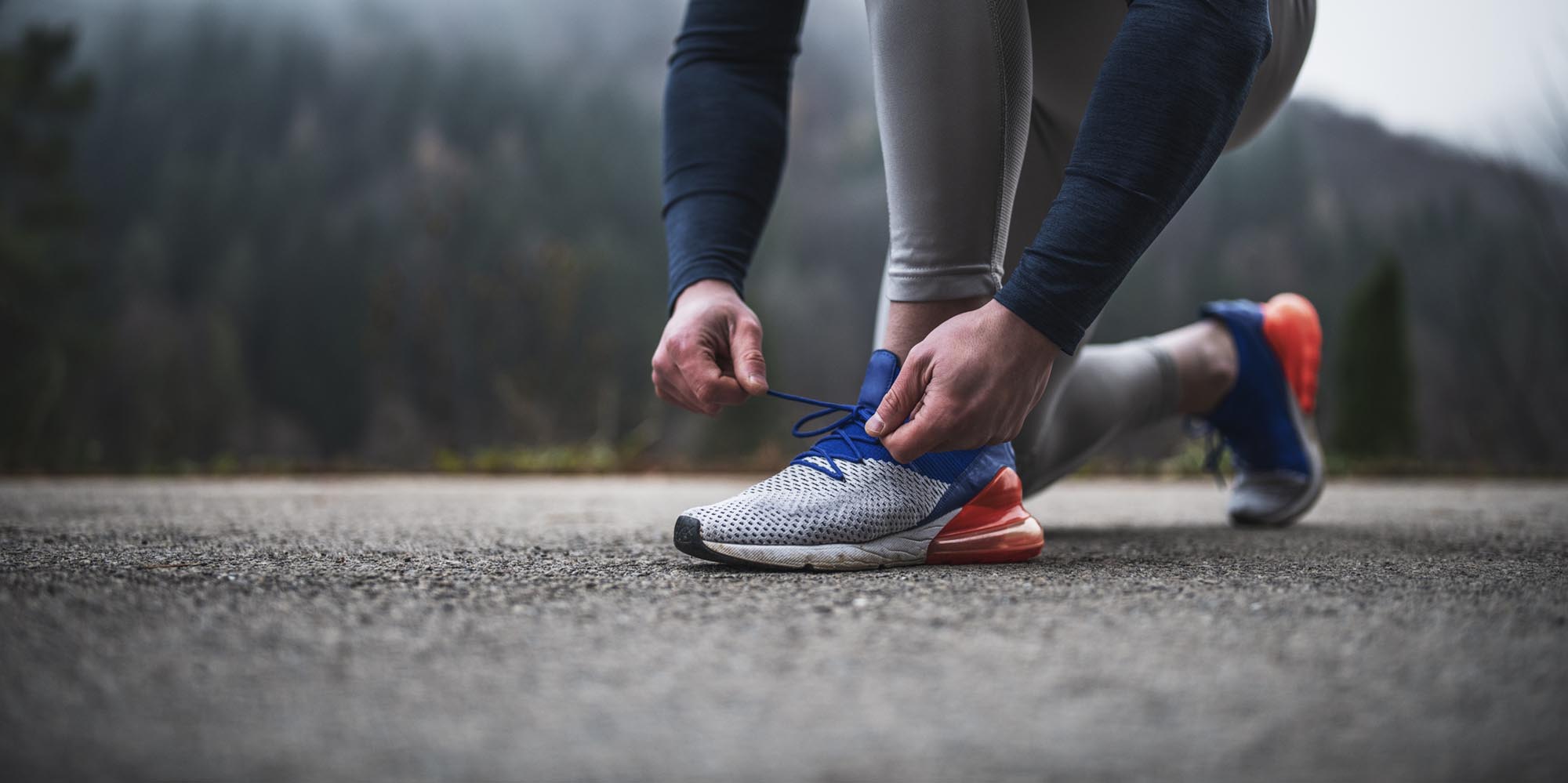 By Katherine Dux, MD, Podiatry
By Katherine Dux, MD, Podiatry
Choosing the right pair of running shoes is crucial for performance and injury prevention. The ideal pair can improve your comfort during runs, boost your running efficiency, and help avoid conditions stemming from improper footwear. Unfortunately, it can be difficult, especially when there are so many factors you need to consider to find a shoe that aligns perfectly with your running goals and personal needs.
The following tips can help you choose the best running shoes for your individual needs, personal goals and type of running experience.
What surface are you running on?
The type of surface you run on significantly influences the kind of running shoe you should choose. Each running environment presents its own challenges and requirements.
Road running shoes
These are perfect for those who run on streets, sidewalks, or treadmills. Designed to absorb shock and maintain comfort on hard surfaces, road running shoes are typically lighter and have less aggressive tread patterns compared to trail shoes. They often feature more cushioning to protect against the continuous impact of hard surfaces.
Trail running shoes
If your running takes you off-road, trail running shoes are essential. They are constructed with aggressive tread patterns to provide grip on muddy, rocky, or uneven surfaces. Additionally, they offer extra stability in the ankle to support and safeguard your feet from the varied and rough terrain found on trails.
Cross training shoes
For runners who do a variety of workouts – such as weightlifting at the gym and short runs – cross trainers are suitable. They provide a good balance of cushioning and flexibility, which is great for a gym session but also stable enough for running on flatter surfaces. Cross training shoes are designed to enhance floor contact, improve stability, and support lateral movements, making them versatile for a variety of physical activities.
Understanding your foot and running style
Every foot is different and every runner needs to understand the unique needs of their feet in order to choose the best running shoes for them.
- Orthotic needs: For runners who use orthotics or specialized insoles, compatibility with your running shoes is important. The right pair should have enough depth and width to comfortably accommodate any orthotic device without feeling overly tight or causing foot displacement.
- Cushion preference: Some runners favor a soft, cushioned shoe that feels like running on clouds, while others prefer minimal cushioning for better feel and control of the running surface. Cushioning not only affects comfort but also impacts the force with which your body hits the ground.
- Foot mobility and arch type: Understanding whether you have a high arch, flat feet, or neutral arch is fundamental in choosing the right shoe. This affects your choice as different shoes provide varying levels of arch support. Similarly, consider how much your feet move. If you have a stiff foot, you might benefit from a more flexible shoe to aid natural movement, whereas more mobile feet might require shoes that offer increased support to reduce excessive movement.
-
Running form: The part of your foot that strikes the ground first has implications for your shoe choice:
- Heel runners: Most common among runners, requiring shoes with excellent heel cushioning to reduce impact.
- Midfoot runners: These runners need a balanced cushioning throughout the shoe for support at the balls of the feet.
- Forefoot or toe runners: Less common, primarily only used when sprinting, these runners require cushioning concentrated at the forefoot.
When should you replace your running shoes?
Running shoes have a limited lifespan. While most won't start falling apart for hundreds of miles, their effectiveness will begin to deteriorate. The general rule is to replace your running shoes every 300 to 500 miles, but this can vary based on several factors.
Heavier runners or those with a more aggressive running style may need to replace their shoes more frequently due to increased wear and tear. They may also choose high-quality shoes with durable materials which may last longer, whereas lighter, more minimalistic shoes might wear out faster. If you run on rough, uneven terrain, this can reduce a shoe’s lifespan, as can frequent road running due to the hard impact with pavement.
Regularly inspect your shoes for signs of wear, particularly in the midsole cushioning, which can harden and lose its shock absorption. Changes in running comfort and the onset of unusual aches and pains can also signal that it's time for a new pair.

Choosing the right support for your foot type
When it comes to running, one shoe type does not fit all. You want to choose a pair that is made for your preferred level of support that matches your foot type and running mechanics.
Neutral shoes
These are designed for runners with a neutral gait who do not exhibit significant overpronation or supination. The wear pattern on a neutral runner’s shoe is typically uniform across the forefoot with slight wear to the heel. These shoes offer a balance of cushion and support without altering the runner's natural stride.
Stability shoes
These are ideal for runners who exhibit mild to moderate overpronation. They include features like dual-density midsoles, which provide firmer support along the inner side of the shoe to prevent excessive inward rolling of the foot. Stability shoes help maintain proper alignment, which can improve running efficiency and reduce injury risk.
Motion control shoes
For runners with moderate to severe overpronation, motion control shoes offer the highest level of support. They often feature stiffer heels or a design that counters excessive inward foot rolling. These are particularly beneficial for heavier runners who need substantial support and durability to maintain proper foot alignment.
When choosing the right support, consider consulting with a specialist at a running shoe store who can analyze your gait and recommend a shoe that matches your specific needs.
How to find the best fit
There is more to achieving the perfect fit than knowing your shoe size. Here are key tips to ensure you find the best fitting shoes:
- Time of day: Always shop for running shoes in the late afternoon or evening. Your feet naturally expand throughout the day, so trying on shoes when your feet are at their largest will help you find a fit that is comfortable even on long runs.
- Wear appropriate socks: Bring the socks you plan to run in. The thickness and material of your socks can significantly influence how your shoes fit and feel, ensuring there are no surprises during your first run.
- Bring orthotics if needed: If you use any orthotic devices or specialized insoles, have them with you when trying on new shoes. This can impact the volume inside the shoe and can affect the overall fit and comfort.
- Get professionally measured: Sizes can vary between brands and even between different models within the same brand. Getting your feet measured professionally can help you start with the right size as a baseline.
- Try multiple brands and models: Don’t limit yourself to one brand or model. Running brands are constantly coming out with new options, and a brand that worked for you in the past may not work for you in the future.
- Check for adequate space: Ensure there is about a thumb's width of space between your longest toe and the end of the shoe. This space allows your toes to move freely without rubbing or pinching at the front of the shoe.
- Feel for secure fit: The shoe should fit snugly around your midfoot and heel, without any slipping. A good fit means your foot feels secure but not squeezed, and there is minimal movement of the foot inside the shoe as you walk or run.
- Take a test run: Most specialized running stores have space or even a treadmill for you to take a brief run or walk. This can help you feel how the shoes perform under actual running conditions. Pay attention to any discomfort or sliding of the foot, which can indicate a poor fit.
Finding the perfect fit for your running shoes is crucial not only for comfort but also for preventing injuries. Consider the type of runs you typically engage in, whether they are long-distance, sprints, or varied terrain adventures, as different styles and designs cater to varying demands. Additionally, think about your individual running style and the support required for your unique foot anatomy. Taking the time to properly assess these factors can make a significant difference in your overall running experience. Remember, the right shoes can enhance your performance and help maintain your foot health over time.
Dr. Katherine Dux is an Associate Professor and Program Director of Podiatric Surgery Residency at Loyola Medicine. She focuses on any and all foot and ankle pathologies, including foot, ankle and sports medicine injuries. She completed her residency at the Loyola University Stritch School of Medicine.
Book an appointment today to see Dr. Dux by self-scheduling an in-person or virtual appointment using myLoyola.

